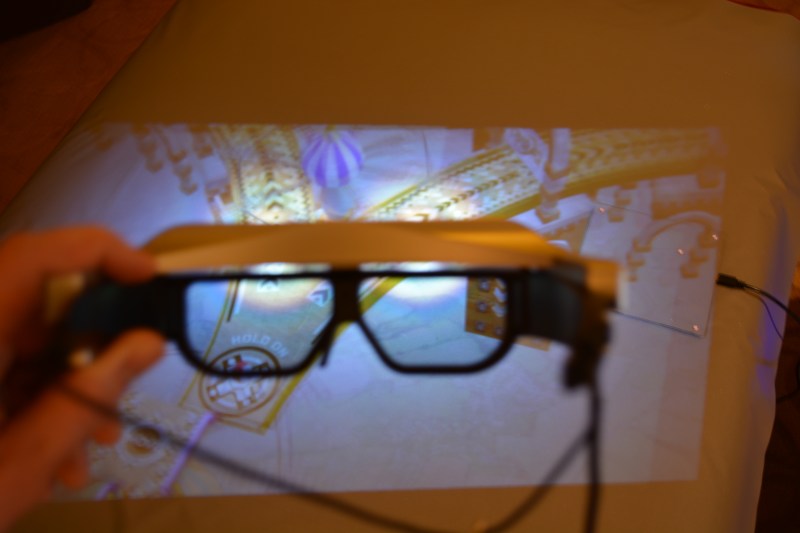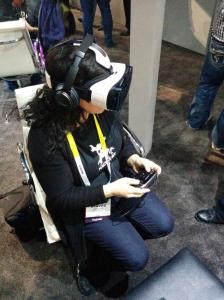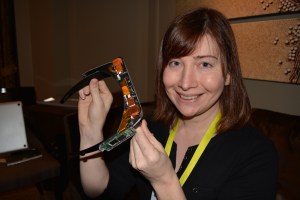At long last I had the opportunity to try out the CastAR, a glasses-based Augmented Reality system developed by Technical Illusions. The hardware has been in the works now for a couple of years, but every time we have come across a demo we were thwarted by the long lines that accompany them. This time I was really lucky. [Jeri] gave us a private demo in a suite at the Palazzo during CES 2015. Reflecting on the experience, CastAR is exactly the type of Virtual Reality hardware I’ve been longing for.
CastAR v Oculus


CastAR completely solves this particular problem. The hardware uses polarized glasses which have two 720p projectors and two cameras built into them. The frames feel like a set of large sunglasses with thick plastic frames and do not block your peripheral vision or the ability to look around the room. You could play games with friends while sitting around the table and still look at the people and the room normally. Of course the digital part of the experience could also be viewed remotely if only three people were in one place and wanted a fourth for the evening’s festivities.
Perhaps an unintended featured demonstration was the fact that Technical Illusions had draped some material over an ottoman in the hotel room and it performed perfectly as the gaming surface. Since the retroreflector is fabric you can roll this up and take it with you quite easily.
Join me after the break for a view of the hardware and a tease about the next version.
The Hardware
In addition to the glasses, CastAR relies on a computer to drive the experience, a passive infrared marker which the cameras uses to measure your movement, and a retroreflective material on which each person’s experience is projected. Put this material anywhere and the projectors will fill it with the virtual space. It’s truly a remarkable effect as light only reflects from it in the exact angle it originated. This means that you will see light from your glasses’ projects but your companions will not. Put another way, multiple people wearing CastAR see their own Augmented Reality experience and they don’t interfer with each other. A simple for-instance is people playing Scrabble and they all see the letters oriented to their own point of view. Ambient light from the room will also have a negligible effect on your projection as it will reflect back to the light source and not toward your eyes.
I found the projectors to be an incredible piece of engineering. [Jeri] recounted her experience developing them. Early on she ordered stock lens and stacked many of them together in order to achieve the desired effect. When approaching production she contracted an optics firm to turn her prototype into reality. They fed her lens numbers into their simulation software and told her the setup basically shouldn’t work. After a bit of back and forth, which included [Jeri] swapping the firm’s prescribed lens ordering, she ended up making a shorter total optical path than the experts. It’s a clear case of innovation that came about because she wasn’t limited by “what is possible”.
Next Gen Hardware
Technical Illusions is beginning to fulfill the Kickstarter units now. But [Jeri] is already hard at work on the next revision of the hardware. I asked if they had run more production units than the number of backers in order to put them up for sale and they have not. The plan is to improve function while reducing size… mass production will wait for this benchmark which is nearer than I would have guessed.
I have to beat around the bush a little bit here. [Jeri] showed me the prototype of the projector/camera hardware for the next version. There’s a lot of competition in the AR/VR world so I can’t share a picture or too many details. What I will say is that I was astonished by how small the module has become. The board, projectors, and cameras could be lost in your pocket if you were careless enough to drop it in there.
Searching for a Downside

Of course personal opinions about full virtual reality immersion will differ from mine. If you are looking to completely replace your surroundings with a digital world this could be considered a drawback. At the same time, after seeing what CastAR can do with retroreflective material strewn about the room I posit that someone will hack this into full VR either using a head-shroud or a full room of the material (holodeck). The only question I have is will this be done first by one of the Kickstarter backers or by [Jeri] and [Rick] themselves?




















They already have a plan for full VR, actually—have a look at the AR/VR clip-on on their website. You just put the clip over the glasses, and you can either turn it into full VR, or into full-on augmented reality, with things overlaid onto the real world.
Source: I’m an original kickstarter backer. Thanks for the preview! There’s been a lack of press relative to other VR systems.
Curious about all the Valve details (gossip?) surrounding this project, if any. Looking pretty great though, excited to see this be commercially available.
Go look up theamphour podcase she talked about it there.
Cool, thanks.
It was developed as part of Valves investigation in VR.
At some point, they (Valve) went a completely new route with the VR (which eventually lead to the Oculus DK2) and then 2 Valve employees decided they didnt want to stop what they worked on, Valve/GabeN agreed it was pretty sweet, and let them continue, Technical Illusions was born, and CastAR was posted on KS.
Heres part of the story, Google should be able to find you the nitty gritty details:
http://www.theverge.com/2013/5/18/4343382/technical-illusions-valve-augmented-reality-glasses-jeri-ellsworth-rick-johnson
And heres their original KS (also containing some additional details)
https://www.kickstarter.com/projects/technicalillusions/castar-the-most-versatile-ar-and-vr-system
Something thats actually missing from the article is that this CastAR also does VR, theres a special shield you can attach that just makes the projectors project to surface right infront of your face, and apperantlly thats very playable.
Finally, Valve VR, has been pretty hidden under wraps before and since CastAR broke free, but its been said they still work on a VR solution of their own. Heres some info on their own stuff: http://www.roadtovr.com/hands-valves-virtual-reality-hmd-owlchemy-labs-share-steam-dev-days-experiences/
Finally its known for a fact they’ve been a big help to Oculus, sharing their findings/ideas with them, which actually lead to the DK2 version, theres also been persistant rumours that Valve is considering to just send all their findings to Oculus and let them take on VR, but idk if that still stands after Facebook aquired Oculus. (partially because recently Steam appears to want to become “Facebook for gamers”)
All of the info mentioned above has been gathered over the past months by keeping a close eye on Valve and what sparse details trickle out into the public.
I don’t think valve will ever successfully release something from their hardware research projects, even the steam box seems to not have a bright future.
I also don’t believe valve was ever involved with Oculus in any way, but that’s another matter
as far as i know they had a clip on
see here http://www.engadget.com/2013/10/14/castar-kickstarter-launch/
No need to hack into full VR. In the final KS product release they’ll sell a VR clipon that is purpose built for the task. The clipon is an optical path that redirects the light from the project down and around straight in the eyes.
Oh yeah, [Jeri] told me about that but I must not have understood what she was getting at.
No links to their site, kickstart campaign(s)?
Check out the first paragraph, links to CastAR site.
Comparing this with Oculus Rift is not really apples to apples comparison, as each are serving a very different role. CastAR glasses are more towards augmented reality, adding virtual content into the real world.
On the other hand, Rift is a classic virtual reality device, designed to make you feel being “in a different place”, what is known as “presence” in the VR community. That’s why it *has* to be enclosed and isolating from the outside world (immersion), that is by design. In fact, CastAR glasses offer a clip-on shield for exactly this purpose as well.
The links:
http://technicalillusions.com/
And the original Kickstarter:
https://www.kickstarter.com/projects/technicalillusions/castar-the-most-versatile-ar-and-vr-system
“Comparing this with Oculus Rift is not really apples to apples comparison,”
Its the new Google Glass competitor! [/Tech press]
Got to try an earlier version at Maker Fair last year. A couple things:
* The field of view is limited. I understand they went through some trouble to get the widest beam angle possible out of the projectors, but it still doesn’t come close to covering your peripheral vision. This is not really noticeable, though, when you are looking at a table.
* The image above gives you a pretty good idea of what the contrast and colors are like. Its better in a dark room, but obviously projectors aren’t going to be as vibrant as an OLED screen strapped to your face.
* The projectors were aimed slightly downward. The idea being that you are most likely to be looking down (like at a table) than level or upwards at the ceiling. When I was looking at a wall, though, I had to tilt my head back a little kind of like people with bifocals will sometimes do. They may have changed this since then.
That’s good to know. I’m interested in these (probably at the next revision), but I intend to use them for virtual whiteboarding (I may have been unduly affected by the new Iron Man), so I’d be looking at a wall much more often than a table.
[quote]They fed her lens numbers into their simulation software and told her the setup basically shouldn’t work. After a bit of back and forth, whichh included [Jeri] swapping the firm’s prescribed lens ordering, she ended up making a short total optical path than the experts. [/quote]
This paragraph makes no sense to me.
Yeah, should have been “shorter total optical…”. Thanks, fixed.
I can’t wait for AR to take off. Thinking of a game like Supreme Commander but where you and your friends use AR to play multiplayer skirmishes on your coffee table. You each see something different, but you play and interact on the same surface. You use gestures to interact.
Exactly the usage I’m looking forward to.
I’m with you on this one. My wife and I play Catan regularly with friends. I think that game could be awesome with AR… expansion packs would be so much easier and you could get game rule assistance as far as placing pieces and removing them from the table.
The infrared marker is active not passive (hence the power and the chip).
I really hope the resolution gets bumped! Still fantasizing about a room wallpapered with retroreflector…
Too bad all the interesting pictures are nothing than a blur. Next time, please turn your camera to auto everything.
Those projectors were capable of something like 120Hz per projector too, and you could multiplex them.
Projecting against water mist could be really interesting too, especially if you could shape/contain the mist with e.g. ultrasonics. You could get something very much like R2D2s holographic projector that way, and maybe even make it haptic. Wet, but haptic.
What happens when you look someone at the eyes?
Well they are polarizing lenses so one eye will see one eye and other will see other one (same with projector light even if it’s pointing a bit down)
Not much. The projectors are pretty low lumens (under 1 currently). You see two white dots and that’s about it.
Nice! Then I’m totally fine with these… I may even like them!
2 pico projectors and the package is $350? I did not know 720p pico projectors were only around $150
The pico projectors are more like $50 as modules instead of end-user devices with retail markup
I actually think they should project the images into the glasses instead of external surfaces.